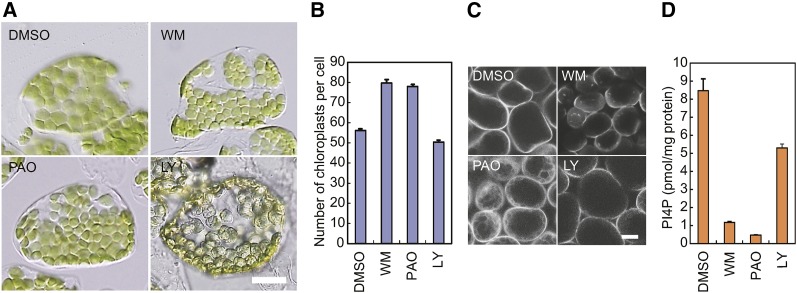Figure 2.
PI4K Inhibition Increases Chloroplast Number, Decreases Chloroplast Size, and Decreases the Level of PI4P.
(A) Chloroplasts of wild-type plants treated with inhibitors of PI4K and/or PI3K. Chloroplasts in a single mesophyll cell are shown. Wild-type 4-d-old seedlings were transferred onto agar plates with 200 μM WM, 25 μM PAO, or 50 μM LY294002 (LY) or onto plates lacking inhibitors (DMSO) and grown for 2 weeks. Bar = 10 μm.
(B) Statistical comparison of the number of chloroplasts per mesophyll cell in inhibitor-treated plants. Error bars represent se (n = 50 cells).
(C) Intracellular localization of the PI4P biosensor, eYFP-PHFAPP1, in the cells of transgenic plants treated with PIK inhibitors. Transgenic plants overexpressing eYFP-PHFAPP1 were treated with WM, PAO, or LY294002, or without inhibitors (DMSO), for 3 d. Images of YFP fluorescence were taken using a confocal laser-scanning microscope. Bar = 20 μm.
(D) PI4P levels in the isolated intact chloroplasts prepared from plants treated with PIK inhibitors. Wild-type plants were treated with WM, PAO, or LY294002, or without inhibitors (DMSO), for 3 d. Intact chloroplasts were isolated, and the amounts of PI4P were measured using a PI(4)P Mass Strip Kit. Error bars represent se (n = 3).

